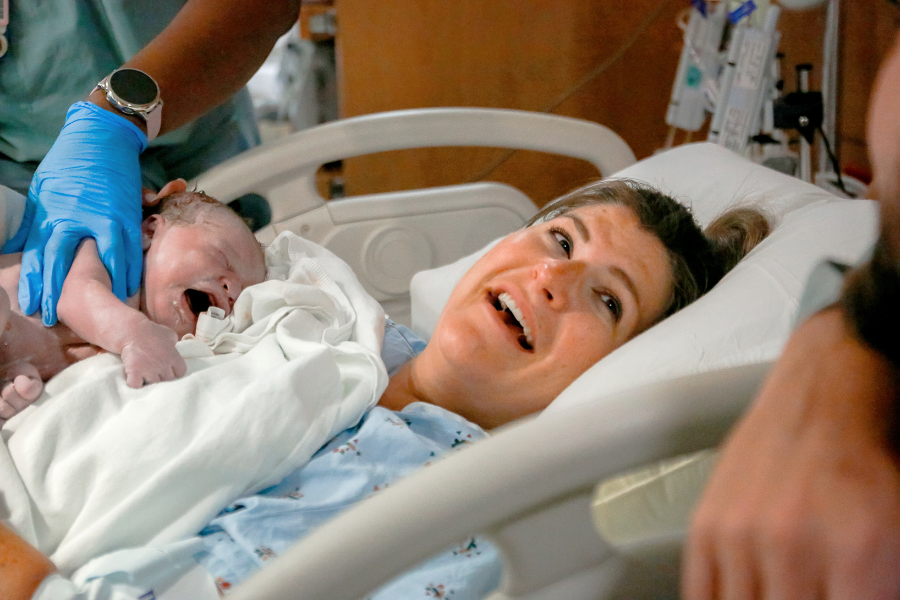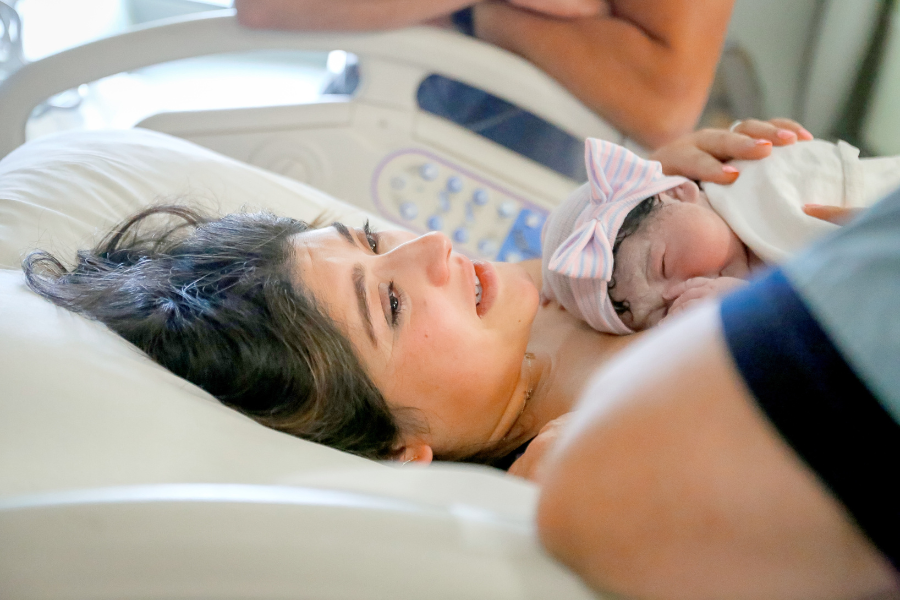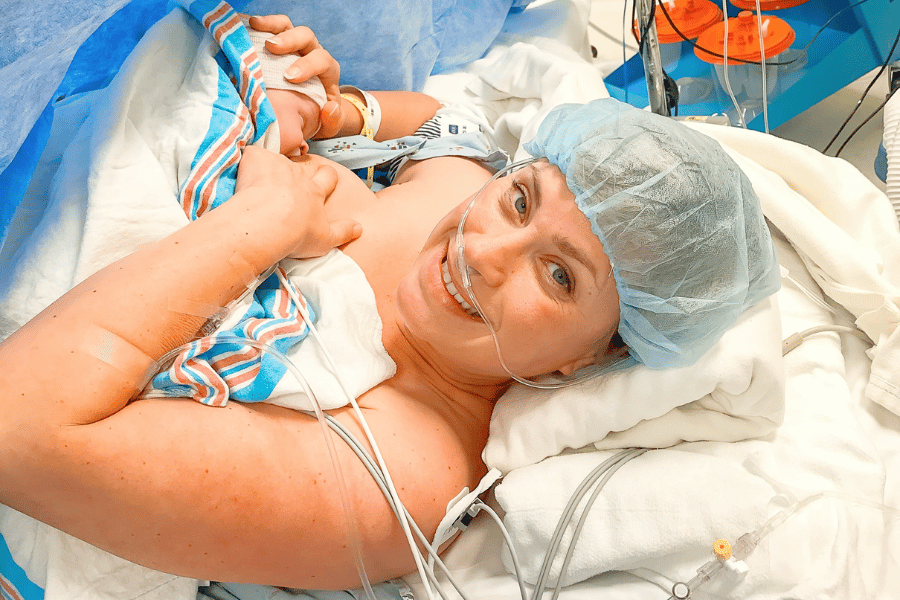Hi there! I have to admit, this post is going to be a bit different than one of my typical pregnancy posts!
I have quite a few nursing students who follow me on Instagram (love you guys!), and I know this is something all of you wonder (or at least those of you who are interested in becoming a labor and delivery nurse like me!).
So, I put together this little guide with all the information about what it’s like to be a labor and delivery nurse, how it’s different than other nursing positions, and all the skills you’ll need and use.
Follow @mommy.labornurse on Instagram to join our community of over 650k for education, tips, and solidarity on all things pregnancy, birth, and postpartum!
What does a labor and delivery nurse do?
Any med-surge nurse who’s transferred to an L&D floor can tell you that our roles and responsibilities as labor nurses are DRASTICALLY different than your average floor nurse.
Our patient ratios are typically 1:1 or 1:2 depending on the situation (that means we only care for one or two patients at a time, as opposed to four or five), and a day in the life on our floor looks a lot different than any other part of the hospital!
What roles do labor nurses have?
Let’s go through a typical day if I were to set foot on the floor.
Our hours are flexible, but most hospitals have nurses work 12-hour shifts. This means you either go into work at 7:00 AM or 7:00 PM.
And actually, it’s not exactly 7, it’s more like 6:35 or 6:40.
My hospital requires nurses to be present on the floor at 6:50 to get report from the previous shift. But, I also have to change my clothes before I get on the floor!
That’s right, I don’t even wear my scrubs in the car!
We change into OR scrubs upon arrival to the hospital. These are supplied by the hospital, so that’s one little perk that I don’t have to buy or launder any of my own scrubs!
So, I usually arrive to work at about 6:35, park, and it takes me about 10-15 minutes to walk into the hospital, get up to the area where we change, clock-in, and change into some fresh scrubs.
After I’m changed I walk up to the floor and check my patient assignment.
I’m usually on the floor (aka I have a laboring patient), but sometimes I work antepartum, triage, or in the operating room caring for someone having a scheduled C-section.
What’s antepartum and what’s triage?
Antepartum is a unit that specifically for moms who need to be hospitalized during their pregnancies, but they aren’t in labor yet. They are too “sick” to be cared for in an outpatient setting.
A few reasons why you may admitted to an antepartum unit include:
- Your water broke early in your pregnancy, but you’re not in labor yet
- Your blood pressure is severe and needs to monitored on an inpatient floor
- You’ve been bleeding too frequently (let’s say you have a placenta previa or a partial placental abruption)
- Your baby is having heart rate dips frequently, and you’re still preterm
Triage is where you’d come in to be assessed if you are in labor! Some smaller hospitals do not even have a triage, and they use labor beds to triage patients, but where I work there is a separate unit.
Triage is also for patients who are not laboring. Let’s say you have bleeding, you’re not feeling your baby move as frequently, you think your water broke, you’re having severe abdominal pain, headache, flu symptoms, blurry vision, or more!
Basically, if you call your provider, complain of a symptom, and they tell you to head to the hospital, you’ll wind up in triage for assessment.
Think of triage as a mini-ED for pregnant ladies. (In fact, we just changed our name at our hospital to the OBED instead of triage!)
Okay, so back to my assignment!
After I figure out which patient I have, I go and find the off-going nurse to receive report!
We usually try and give report in the room but depending on the situation sometimes it’s better to do report outside of the room. It all depends, and I usually always ask the off-going nurse what she thinks. In-room report is usually better because the patient is involved, and she can chime-in if there is something we’ve overlooked during her report.
Out-of-room report is sometimes better though if the patient is resting, and we don’t want to bother her with talking!
What do I learn during report?
During report, I learn about the patient’s medical history, what brought her to the hospital, what she wants during her birth (things that may be on a birth plan), her current state, and what’s about to happen next (if the provider is going to come and check on her, or if I need to do anything right now).
After the off-nurse leaves, I usually introduce myself, write my name on her whiteboard, and do a full assessment of my patient. This includes:
- Listening to her heart/lungs
- Palpating her contractions
- Checking her swelling, reflexes, and asking her about any symptoms she’s been having (like nausea or vomiting)
- I check her IV lines to make sure they are working properly and look at her IV pumps if there are any
- If she’s got an epidural, I also assess her sensations and ask her how it’s been working.
- Assess her pain from a scale of 0-10 and ask if there is anything I can do right now to help her with her pain
I don’t usually do a cervical check upon arrival unless it’s necessary.
Then we talk a little bit about how she’s doing, what I can do to help, and answer questions that she or her partner currently have.
It just kind of depends on what situation the patient is in as to what I do next!
If she’s completely dilated and pushing, I continue to push with her. If she’s being induced then I titrate her Pitocin accordingly!
Here are some more skills/roles that I would typically do in a day!
Related Reading: Wondering What Happens At Delivery?
Related Reading: Tearing Vs. Episiotomy
Labor and delivery nurse skills
*These are all the ones I could think of but I know my co-workers would say there are more, lol*
Labor support
This is a biggie, and probably the one I do the most! Unless mama has a doula and/or a SUPER supportive partner, I act as that person for the majority of patients. Even mamas who do have doulas I do labor support with many times! Some mamas it takes a few set of hands!
Labor support includes helping mom change positions, counter-pressure, and/or emotionally helping mom through contractions!
Giving medications
Yep! We give medications just like any other nurse would do in the hospital! A nice part is that we are usually giving the SAME medications to most patients (Motrin, Magnesium, Pitocin, IV fluids, Tylenol, Labetolol, Cytotec etc.). It’s not like we have 5 different patients with different co-morbidities all in the same day!
It’s still really important to know the side effects, dosages, routes of administration, adverse effects and more!
Vitals
We do vitals signs pretty frequently too! Sometimes every 15 minutes! SOME labor and delivery units have techs that do vital signs for nurses, but most places the nurses do all the vitals!
Cervical checks
Ahh yes, cervical checks! This is an important assessment that every labor nurse learns how to do. It takes some practice, but after a while, it becomes very easy to find a cervix, even a super posterior one! There is a such a learning curve with cervical checks, and they are also pretty subjective too (aka, my 5 may be your 6).
I always try to be a gentle as possible (because I’ve had my fair share during my own pregnancy and I know how sucky they are), and also be a quick as possible!
Assess fetal monitor strips
This is a big part of our jobs as well! We gotta watch those dang strips ALL THE TIME! We take classes so we know how to assess monitor strips correctly, and it’s really important that if there is something wrong we recognize it and do something about it!
The monitor doesn’t only read baby heart rate, but also your contractions!
Intervening in an emergency
Soooo many emergencies can happen on a labor and delivery floor! Postpartum hemorrhages, fetal heart rate decelerations, emergency c-sections, placental abruptions, shoulder dystocias…
I don’t want to scare you, I actually want to put your mind at peace because we know what to do to help if any of these situations arise!
Setting up for epidurals
Guess what? Getting an epidural is a process. (you can read more about it here). It’s not just a quick shot that you get in your back. It takes some prep, and some help on our part to get things set up for anesthesia! Along with setting up, we also need to really monitor you closely after you receive one!
Going to the OR
Some days we are assigned to the OR (operating room), to care for patients that are having scheduled c-sections. When this happens, we act as a “circulating” nurse for the OR. We are also responsible for assessing patients in the PACU (post-anesthesia care unit) for a few hours after surgery!
Calling providers with updates
A provider may be overseeing care for 10 laboring women at a time, but his/her nurses are at the frontline! Part of our job is to update your provider of what’s going on with YOU!
Coordinating care with other parts of the hospital
Sometimes mama needs labs, meds from the pharmacy, a psych consult, or a CT scan! We have to make sure all of these things happen!
Caring for stillbirth mamas
This deserves its own little section. This is something that your typical “what does a labor and delivery nurse do” post doesn’t include, but it’s a very important role that we take on. Every so often we, unfortunately, have to care for a sweet mama experiencing a stillbirth. This process varies, but it comes along with a lot of extra support, coordination, paperwork, and emotions.
Fundal rubs
So sorry! But, we have to push on the top of your uterus after you have a baby. It’s quite uncomfortable, but it’s necessary. It’s one of the ways we make sure you’re not bleeding too much during postpartum!
Pushing
Pushing with a patient can take less than 10 seconds, or more than 4 hours. Regardless of how long it takes, we help ya do it!
Charting
Probably 50% of our job, easily. Charting is super important, even though it’s time-consuming. Charting allows us to make sure everything is going to plan, and allows other members on your healthcare team to read about your progress. It’s also super important if there were ever a legal battle to come from your birth process.
Education
See all of this stuff that I teach you guys via my blog? I do that in person too while I’m taking care of ya!
Helping with breastfeeding
We always try to initiate breastfeeding (if that is mama’s feeding plan) within the first two hours after birth. So, helping you get that first latch is part of our roles as well!
Whew! That’s a lot! Are you aspiring to be an L&D nurse? I wanna hear from you! Leave me a comment!
Happy Nursing! 🙂
Related Reading: Doula versus a Midwife? What’s the Difference?





